It looks like you're using an Ad Blocker.
Please white-list or disable AboveTopSecret.com in your ad-blocking tool.
Thank you.
Some features of ATS will be disabled while you continue to use an ad-blocker.
share:
www.defencetalk.com...
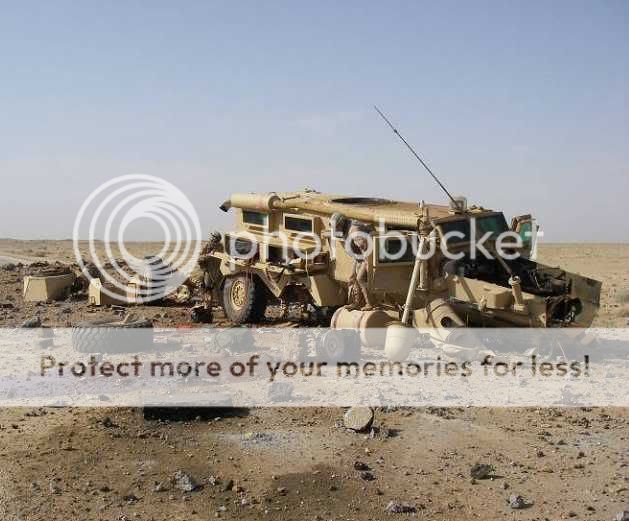

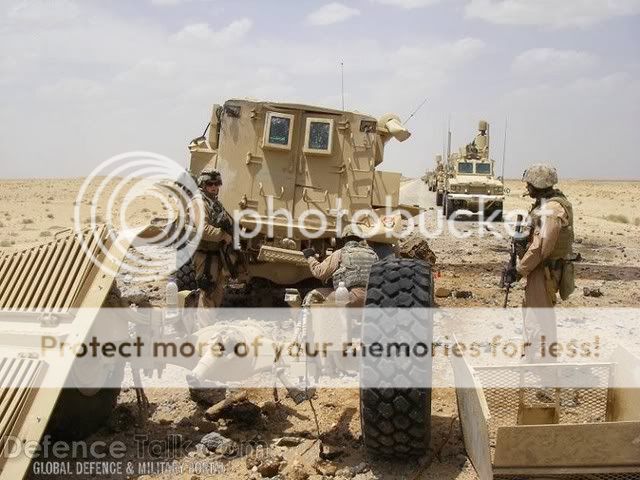
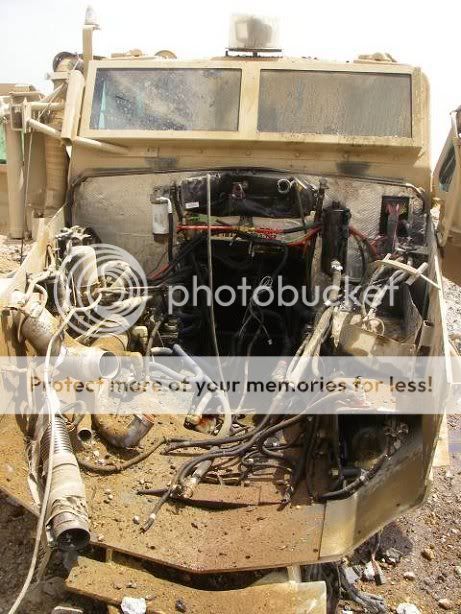
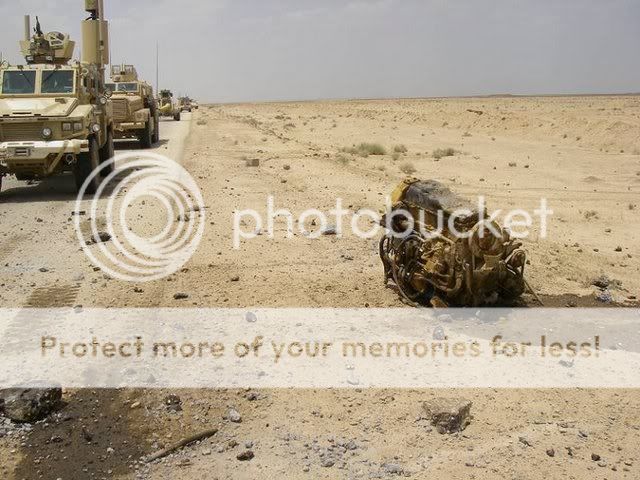
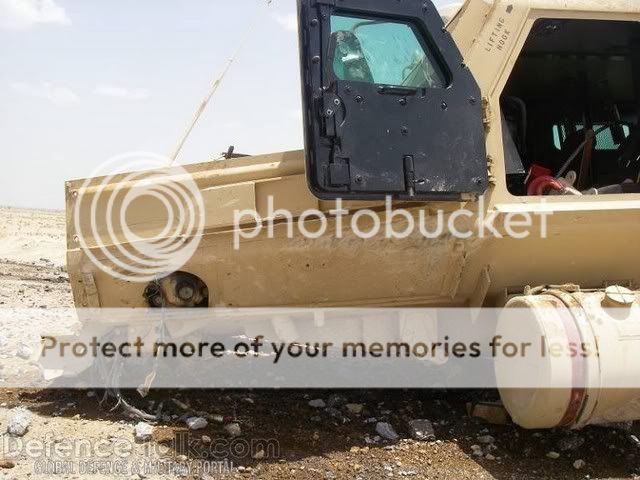

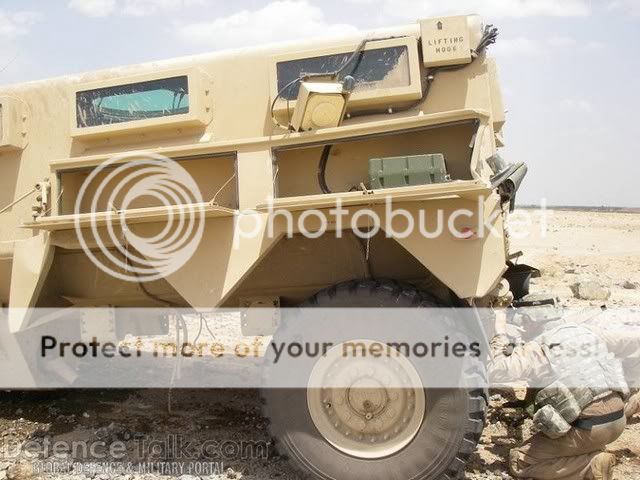
Pretty much says it all about how very well it protects the occupants in this type of vehicle. If it were a Humvee we probably lost like 4 or 5 troops along with the destroyed vehicle.
Based on my observation they need to strengthen the front grill since I don't see any penetration in the engine compartment (meaning a big hole in the underside).
[edit on 30-8-2007 by deltaboy]
Remarkable sequence of photographs of a US Marine Corps Cougar mine resistant and ambush protected (MRAP) vehicle after it had been hit by a very substantial IED in Iraq. The crew escaped with only minor injuries and no one was killed, even though the blast ripped the engine from its armored bay and hurled it over 100 yards.








Pretty much says it all about how very well it protects the occupants in this type of vehicle. If it were a Humvee we probably lost like 4 or 5 troops along with the destroyed vehicle.
Based on my observation they need to strengthen the front grill since I don't see any penetration in the engine compartment (meaning a big hole in the underside).
[edit on 30-8-2007 by deltaboy]
Burly system to drive, what a machine to take on a blast like that. I would feel ok riding in one of those bad muthers. I'm sure the impact was not
to fun. I would think about putting the axles back on and towing it with a camel.
A report came out today that the MRAP, while a huge improvement over everything else is highly susceptible to EFP type IEDs. The MRAP can't carry
enough armor to stop the projectile fired when it detonates. They're working on a new light weight armor to stop the projectile they can used on the
MRAP. EFPs make up about 4% of the IEDs used.
From the third photo you can see it's pointing the opposite direction to the rest of the convey. I reckon the whole Cougar was spun round by the
explosion.
The RPG 7 which uses EFP can put a hole through 11 inches of steel. The RPG 7 is the common RPG which has been around since the 60s at least. So I guess they'll need reactive armour, which is what is used on the british bulldog (APC).
The Stryker uses ceramic with a standoff cage for the RPG threat.
I would like to know what the british put on there Couger's (they call them mastiff) Seen comments that is was just a sheet of steel but the same people said the couger was already RPG proof which it isn't. From the in theate shots I've seen it looks like at least 6-8 inches thick, which would be to heavy for steel. And a cage on top of that
Photo
[edit on 30-8-2007 by deckard83]
[edit on 30-8-2007 by deckard83]
The RPG 7 which uses EFP can put a hole through 11 inches of steel. The RPG 7 is the common RPG which has been around since the 60s at least. So I guess they'll need reactive armour, which is what is used on the british bulldog (APC).
The Stryker uses ceramic with a standoff cage for the RPG threat.
I would like to know what the british put on there Couger's (they call them mastiff) Seen comments that is was just a sheet of steel but the same people said the couger was already RPG proof which it isn't. From the in theate shots I've seen it looks like at least 6-8 inches thick, which would be to heavy for steel. And a cage on top of that
Photo
[edit on 30-8-2007 by deckard83]
[edit on 30-8-2007 by deckard83]
Wouldn't a "substantial" IED make a crater? I don't see even a small one.
Not if it's a shaped charge. All the force would be directed in one direction, and what's left over wouldn't leave much of a crater.
should of had some snipers if they really wanted to hurt someone
do the US forces remove their detroyed gear
or is it going to be another afganistan with litterd Russian tanks and so on?
do the US forces remove their detroyed gear
or is it going to be another afganistan with litterd Russian tanks and so on?
They remove it and send it back to where they can strip it down and take the useful parts that weren't destroyed off and use them for spares for
other vehicles that were damaged.
That is money well spent. You can tell they walked away from that. Amazing. What I do find disturbing is they can't seem to make them fast enough
which tells me we could not do what we did in WWII today with our manufacturing capabilities. That could change if congress declares war on someone.
There is not a single shrapnel hole in that entire vehicle and even though the windows are 4" thick or more they still would have spider webbed.
Something happened to this thing for sure, but it seems like an IED wouldve littered the body with shrapnel.
[edit on 8/30/2007 by Kr0n0s]
Something happened to this thing for sure, but it seems like an IED wouldve littered the body with shrapnel.
[edit on 8/30/2007 by Kr0n0s]

Does anyone else think it odd that the engine could be blown clean of its mounts, yet the air intakes - which appear to be aluminium - still retain their circular shape at the mouth? The exhaust manifold still has the mounting flange attached.
Looking close, I think I can make out a couple of intact lugs on the cables leading to the ground point on the right.
I don`t know. This looks too clean to me, almost as though the engine had been scavenged.
reply to post by vox2442
I think the whole thing is odd, you make very good points, add those to mine and things just dont add up.
I think the whole thing is odd, you make very good points, add those to mine and things just dont add up.
That's pretty amazing that a vehicle survives after being hit by an IED as big as that was to survive.
Great vehicle.
Great vehicle.
reply to post by deckard83
The British Mastiff is an improved Cougar. It has added ceramic armour and a rpg cage. It's much more survivable than a Cougar. And the Cougar is a hell of a good bit of kit.
The British Mastiff is an improved Cougar. It has added ceramic armour and a rpg cage. It's much more survivable than a Cougar. And the Cougar is a hell of a good bit of kit.

This is probably the best picture of the lot. It demonstrates nicely what happened.
The blast happened to the front of the wagon, and slightly to its' right. Part of the crater can just be seen behind the vehicle, as it seems to have been spun by the impact. The blast wave hit the front of the grill and penetrated well. The V shaped hull channeled the blast into the engine compartment and in turn ripped the engine off at the lines of least resistence. The cab is highly blast resistant, so the wave followed the line of least resistance, throwing the engine upwards and to the side.
Residual blast waves that were not directed into the engine block flowed underneath the vehicle. The wheels and ancilliary bolt on bits of the vehicle were blown off as they were designed to do. The V-shaped hull directed the blast around the crew compartment, protecting the crew.
The reason that there are few shrapnel marks is that the IEDs used in Iraq tend to have a very high explosive to shrapnel ratio. In other words they are designed to destroy the vehicle with the blast wave. The insurgents have found that shrapnel is fairly ineffective against a well armoured vehicle such as this. The bombs that they lay use low explosive (such as ANFO) as it creates a slower moving but heavier blast wave than HE, (which is more suited to shaped, cutting charges). It is also cheaper and easier to manufacture than HE. The downside is that it is heavy and you need loads of it to do damage to an armoured vehicle. Therefore they don't mess around with things like shrapnel, which doesn't penetrate well and just adds extra bulk and weight to an already heavy bomb.
Paddy,
This is a very intresting and detailed analysis of what is in the photos and for which I give you my thanks.
My read of what you describe is that there is a whole team of people involved in these types of incidents ...from medical to demolitions experts to factory reps. looking for changing trends?? Accumulating a significant data base not ordinarily seen by the general public. Where a product can be improved. etc etc. Even right down to where or whom has the knowlege to build the next type of devices..a fingerprint so to speak.
I am also gathering that there is a extensive dissemination of informations within the trades about these happenings. Once again ...more so than the public is aware.
I find your analysis very very intresting. It has caused me to look closely at these images.
I am also thinkng that this is a quantum leap in survivability from earlier generations of vehicles.
Thank you very much Paddy,
Orangetom
[edit on 2-9-2007 by orangetom1999]
This is a very intresting and detailed analysis of what is in the photos and for which I give you my thanks.
My read of what you describe is that there is a whole team of people involved in these types of incidents ...from medical to demolitions experts to factory reps. looking for changing trends?? Accumulating a significant data base not ordinarily seen by the general public. Where a product can be improved. etc etc. Even right down to where or whom has the knowlege to build the next type of devices..a fingerprint so to speak.
I am also gathering that there is a extensive dissemination of informations within the trades about these happenings. Once again ...more so than the public is aware.
I find your analysis very very intresting. It has caused me to look closely at these images.
I am also thinkng that this is a quantum leap in survivability from earlier generations of vehicles.
Thank you very much Paddy,
Orangetom
[edit on 2-9-2007 by orangetom1999]
Originally posted by vox2442
Does anyone else think it odd that the engine could be blown clean of its mounts, yet the air intakes - which appear to be aluminium - still retain their circular shape at the mouth? The exhaust manifold still has the mounting flange attached.
Looking close, I think I can make out a couple of intact lugs on the cables leading to the ground point on the right.
I don`t know. This looks too clean to me, almost as though the engine had been scavenged.
When a vehical is destoryed the Iraqi's pick them clean. Pesants did the same in Veitnam. Used engine partsd to fix tractors or cars, used tires to make Uncle Ho sandles, ect... Happens in most war zones, they take whatever isn't nailed down.
[edit on 4-9-2007 by Boondoggle]
Originally posted by orangetom1999
My read of what you describe is that there is a whole team of people involved in these types of incidents ...from medical to demolitions experts to factory reps. looking for changing trends?? Accumulating a significant data base not ordinarily seen by the general public. Where a product can be improved. etc etc. Even right down to where or whom has the knowlege to build the next type of devices..a fingerprint so to speak.
This is very true. For example, for every casualty that arrives back in the UK following an incident, every part of that incident is broken down and studied. The casualty is interviewed by a medical team, and their answers are taken and coded to find trends in order to improve kit. For example if they had an injury to the shoulder they may be asked question such as;
What were you hit with?
What range?
What position were you in (patroling/standing/sitting/kneeling/prone/top cover/other)?
What angle was the impact from?
Were you wearing your body armour?
If not, Why not?
What type of armour (ECBA/Kestrel/Osprey)?
Were you wearing your shoulder protection?
If not, Why not?
These answers are then used to re-design the kit that is used. If there are multiple reports of the shoulder protection not being worn because of discomfort, research and testing is carried out by the manufacturers to improve the comfort of this item.
Originally posted by Boondoggle
When a vehical is destoryed the Iraqi's pick them clean. Pesants did the same in Veitnam. Used engine partsd to fix tractors or cars, used tires to make Uncle Ho sandles, ect... Happens in most war zones, they take whatever isn't nailed down.
[edit on 4-9-2007 by Boondoggle]
I dont know when you were there last but we dont leave anything for anyone. That being said...
I guarantee you NOBODY picked this truck clean or were ANYWHERE near it! The scene would have been secured by the rest of the convoy or a QRF. Once secured they would pick up every piece of gear and/or equipment and secured it in another vehicle and wait until the QRF/casevac team showed up to tow it back to base. We dont leave men or gear behind.
new topics
-
Maestro Benedetto
Literature: 1 hours ago -
Is AI Better Than the Hollywood Elite?
Movies: 1 hours ago -
Las Vegas UFO Spotting Teen Traumatized by Demon Creature in Backyard
Aliens and UFOs: 4 hours ago -
2024 Pigeon Forge Rod Run - On the Strip (Video made for you)
Automotive Discussion: 5 hours ago -
Gaza Terrorists Attack US Humanitarian Pier During Construction
Middle East Issues: 5 hours ago -
The functionality of boldening and italics is clunky and no post char limit warning?
ATS Freshman's Forum: 7 hours ago -
Meadows, Giuliani Among 11 Indicted in Arizona in Latest 2020 Election Subversion Case
Mainstream News: 7 hours ago -
Massachusetts Drag Queen Leads Young Kids in Free Palestine Chant
Social Issues and Civil Unrest: 7 hours ago -
Weinstein's conviction overturned
Mainstream News: 9 hours ago -
Supreme Court Oral Arguments 4.25.2024 - Are PRESIDENTS IMMUNE From Later Being Prosecuted.
Above Politics: 10 hours ago
top topics
-
Krystalnacht on today's most elite Universities?
Social Issues and Civil Unrest: 10 hours ago, 9 flags -
Supreme Court Oral Arguments 4.25.2024 - Are PRESIDENTS IMMUNE From Later Being Prosecuted.
Above Politics: 10 hours ago, 8 flags -
University of Texas Instantly Shuts Down Anti Israel Protests
Education and Media: 13 hours ago, 7 flags -
Weinstein's conviction overturned
Mainstream News: 9 hours ago, 7 flags -
Gaza Terrorists Attack US Humanitarian Pier During Construction
Middle East Issues: 5 hours ago, 7 flags -
Massachusetts Drag Queen Leads Young Kids in Free Palestine Chant
Social Issues and Civil Unrest: 7 hours ago, 6 flags -
Meadows, Giuliani Among 11 Indicted in Arizona in Latest 2020 Election Subversion Case
Mainstream News: 7 hours ago, 5 flags -
Las Vegas UFO Spotting Teen Traumatized by Demon Creature in Backyard
Aliens and UFOs: 4 hours ago, 4 flags -
2024 Pigeon Forge Rod Run - On the Strip (Video made for you)
Automotive Discussion: 5 hours ago, 2 flags -
Any one suspicious of fever promotions events, major investor Goldman Sachs card only.
The Gray Area: 15 hours ago, 2 flags
active topics
-
VP's Secret Service agent brawls with other agents at Andrews
Mainstream News • 62 • : ByeByeAmericanPie -
University of Texas Instantly Shuts Down Anti Israel Protests
Education and Media • 228 • : cherokeetroy -
SETI chief says US has no evidence for alien technology. 'And we never have'
Aliens and UFOs • 72 • : yuppa -
My Poor Avocado Plant.
General Chit Chat • 77 • : JonnyC555 -
New whistleblower Jason Sands speaks on Twitter Spaces last night.
Aliens and UFOs • 61 • : Ophiuchus1 -
Is AI Better Than the Hollywood Elite?
Movies • 2 • : 5thHead -
Gaza Terrorists Attack US Humanitarian Pier During Construction
Middle East Issues • 25 • : CarlLaFong -
Mood Music Part VI
Music • 3102 • : Hellmutt -
Las Vegas UFO Spotting Teen Traumatized by Demon Creature in Backyard
Aliens and UFOs • 9 • : Ophiuchus1 -
British TV Presenter Refuses To Use Guest's Preferred Pronouns
Education and Media • 164 • : Annee
